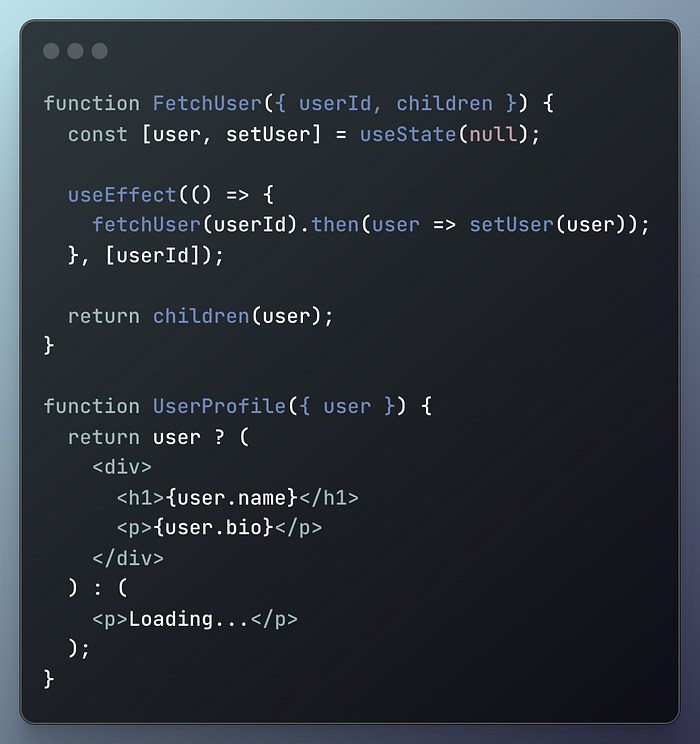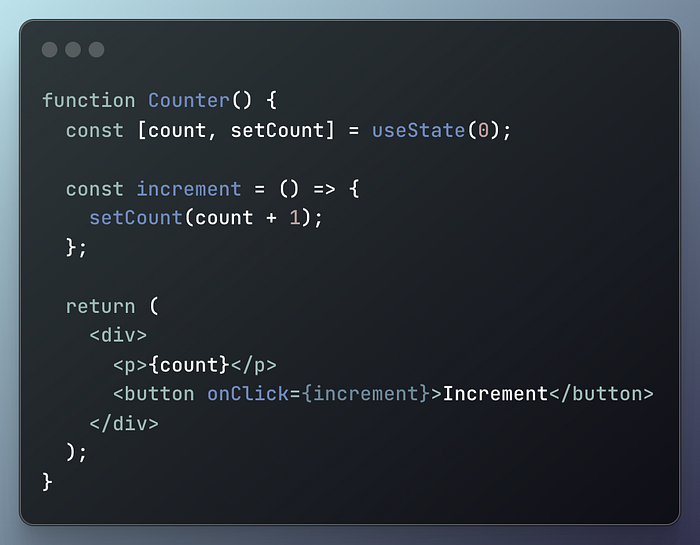Eight Essential Decomposition Strategies for React Components
Elevate Your Development with Proven Techniques for Efficient, Scalable React Components
Decomposing React components into smaller, more manageable units can significantly enhance your application’s readability, maintainability, and performance. In this article, we’ll delve into ten best practices for decomposing React components, complete with examples to illustrate each principle in action.
Single Responsibility Principle
Principle
Each component should have one responsibility and thus one reason to change.
The Single Responsibility Principle (SRP) is a fundamental concept in software development that is particularly relevant in the context of React component design. It stipulates that a component should focus on a single aspect of functionality or responsibility, providing it with just one reason to undergo changes. This principle encourages developers to break down complex interfaces into smaller, manageable, and more focused components. By adhering to SRP, each component becomes easier to understand, test, and maintain, as its scope is clearly defined and isolated from unrelated concerns. This approach not only leads to a more organized and modular codebase but also enhances the reusability of components across the application. Components that embody the Single Responsibility Principle can serve as building blocks that are easy to compose into more complex UIs, contributing significantly to the scalability and adaptability of the application as it grows and evolves.
Example
Before decomposition, you might have a component that both fetches user data and displays a user profile:

After applying the Single Responsibility Principle, you split it into two components: UserProfile (for displaying user data) and FetchUser (for fetching user data):

Usage

Reusable Components
Principle
Design components that can be reused in different parts of your application.
Emphasizing the creation of reusable components is a fundamental principle in React development that fosters efficiency, consistency, and scalability across an application. By designing components with reusability in mind, developers can create a library of UI elements that can be shared and reused in various contexts within the application. This approach not only reduces duplication of code but also ensures that the UI maintains consistency in appearance and behavior. Reusable components, such as buttons, input fields, modals, and navigation bars, can be customized through props, making them versatile for different needs while keeping the codebase DRY (Don’t Repeat Yourself). Additionally, leveraging reusable components accelerates the development process, as developers can compose complex UIs from a well-defined set of building blocks, enabling more focus on business logic and user experience. Ultimately, the practice of creating reusable components is key to building scalable and maintainable React applications, contributing to a more organized and efficient development workflow.
Example
Consider a generic Button component that can be reused across your application with different properties:

Usage

Container and Presentational Components
Principle
Separate components into containers (data fetching) and presentational components (UI rendering).
The distinction between container and presentational components is a foundational principle in React application architecture aimed at enhancing code organization and reusability. Container components are concerned with how things work: they manage data fetching, state management, and generally serve as the data source for presentational components. On the other hand, presentational components focus on how things look. They receive data and callbacks exclusively via props and are responsible for rendering the UI. This separation of concerns allows developers to easily manage and scale their applications by isolating the business logic from the UI layer. It leads to more maintainable code, as UI components can be developed and tested in isolation, independent of the data layer. Furthermore, it facilitates the reuse of presentational components across different parts of the application, each time with potentially different data sources, thus promoting a DRY (Don’t Repeat Yourself) principle. Adopting this pattern not only improves the readability and organization of your code but also enhances component reusability and testability.
Example
Container component:

Presentational component

Use Functional Components and Hooks
Principle
Prefer functional components and Hooks for simpler and more concise components.
The React ecosystem has evolved significantly with the introduction of Hooks, leading to a strong preference for functional components over class-based ones. This paradigm shift embraces the use of functional components and Hooks to create simpler, more concise, and readable code. Hooks, such as useState, useEffect, and useContext, provide a more direct API to the React features you know and love, like state management, side effects, and context, without the complexity of classes. This approach not only reduces the lines of code but also makes components more predictable and easier to debug. By preferring functional components and Hooks, developers can leverage a more declarative and functional programming style, enhancing code comprehension and maintainability. Moreover, this methodology promotes the reuse of stateful logic across components, further contributing to a cleaner and more efficient codebase.
Example
Converting a class component to a functional component with Hooks:
Before

After

Prop Drilling vs. Context API
Principle
Use Context API to avoid prop drilling in deeply nested component trees.
In the development of complex React applications, managing the flow of data across deeply nested components can lead to a common challenge known as “prop drilling.” This occurs when data needs to be passed through multiple levels of components that might not otherwise need to know about the data, leading to cumbersome and hard-to-maintain code structures. The React Context API provides a powerful solution to this problem by allowing data to be shared directly with components that need it, regardless of their position in the component tree. By utilizing Context, developers can significantly simplify data flow and component architecture, making the codebase cleaner, more maintainable, and easier to understand. This approach not only eliminates the need for prop drilling but also enhances component reusability and scalability by decoupling the data-sharing mechanism from the component hierarchy.
Example
Without Context API (Prop Drilling):

With Context API

Keep Your Components Small
Keeping your React components small is a cornerstone of maintainable and scalable application development. Smaller components are easier to understand, debug, and test. They promote reuse, making your codebase more DRY (Don’t Repeat Yourself) and consistent. When components are kept concise, usually under 100 lines of code, they naturally adhere to the Single Responsibility Principle, meaning they are focused on a single task or aspect of the application. This granularity not only enhances the readability of your code by making the structure and flow of your application clearer but also facilitates collaboration among team members, as smaller, well-defined components are easier to discuss, review, and manage within a team.
Moreover, small components lead to better performance and easier optimization. React can more efficiently track and update smaller components, reducing the chance of unnecessary re-renders and improving the overall user experience. When components begin to grow beyond the 100-line guideline, it’s usually a sign that they’re doing too much and should be decomposed into smaller, more focused parts. This process of breaking down complex components into smaller pieces helps in isolating functionality, which is crucial for debugging and testing. By ensuring components are small and focused, developers can more easily identify performance bottlenecks, apply optimizations like memoization, and manage state more effectively, leading to a more efficient and scalable React application.
Directory Structure
Adopting a logical directory structure in your React application is pivotal for maintaining a clean and navigable codebase, particularly as your project grows in complexity and scale. Organizing components by feature or route rather than by file type (e.g., all .js files in one directory, all styles in another) aligns the structure of your codebase with the conceptual architecture of your application. This method makes it intuitive for developers to locate and understand components within the broader context of the application's functionality. For instance, grouping all components related to user profiles under a /UserProfile directory enables developers to quickly find all related files and understand how they contribute to the feature, fostering a modular and cohesive codebase.
Moreover, a feature-based directory structure facilitates modular development and scalability. As features are encapsulated within their respective directories, adding, updating, or removing features becomes a more streamlined process, minimizing the risk of unintended side effects across the application. This structure also supports lazy loading of features, enhancing performance by loading code only when needed based on the route or user actions. By mirroring the application’s functional structure in the file system, developers can navigate the project more efficiently, reduce cognitive load when working on or reviewing features, and enhance collaboration by clearly delineating areas of responsibility within the codebase. Ultimately, a thoughtfully organized directory structure is key to building a maintainable, scalable, and understandable React application.
Performance Optimization
Performance optimization is an essential consideration in React application development, particularly as you decompose your components. Efficient decomposition not only helps in organizing your code better but also plays a crucial role in enhancing the application’s performance. By strategically memoizing components using React.memo, you can prevent unnecessary re-renders of components that have not changed their props. This technique is particularly useful for components that render expensive or complex UI elements, as it ensures that they are only re-rendered when their input props change. Similarly, the useCallback hook is invaluable for memoizing functions, preventing the creation of new function instances on every render. This is especially important for event handlers passed down to child components, which might trigger re-renders if they are considered new on each render.
Moreover, the useMemo hook allows for the memoization of expensive calculations. This means that heavy computational tasks are only re-executed when their dependencies change, rather than on every render. Such optimizations are critical in preventing performance bottlenecks, especially in large and complex applications where render cycles can become costly. By judiciously applying these techniques, developers can significantly reduce the computational load on the browser, leading to smoother and faster application experiences. Keeping performance in mind from the outset — not just as an afterthought during decomposition — ensures that the application remains responsive and efficient, enhancing user satisfaction and engagement. In summary, performance optimization through strategic decomposition and React’s optimization hooks is fundamental to developing high-performing React applications.
Conclusion
In conclusion, adhering to these eight best practices for decomposing React components can significantly enhance the structure, maintainability, and performance of your React applications. From embracing the Single Responsibility Principle to fostering reusable components and optimizing performance, each strategy plays a crucial role in developing a robust and scalable codebase. By implementing these principles, developers can not only streamline their workflow but also create more readable, efficient, and easier-to-manage applications. Remember, the goal of decomposition is not just to simplify the current state of your application but to prepare it for future growth and complexity. As you continue to refine your approach to component architecture, you’ll discover a more enjoyable and productive development experience, paving the way for high-quality, maintainable React applications.
